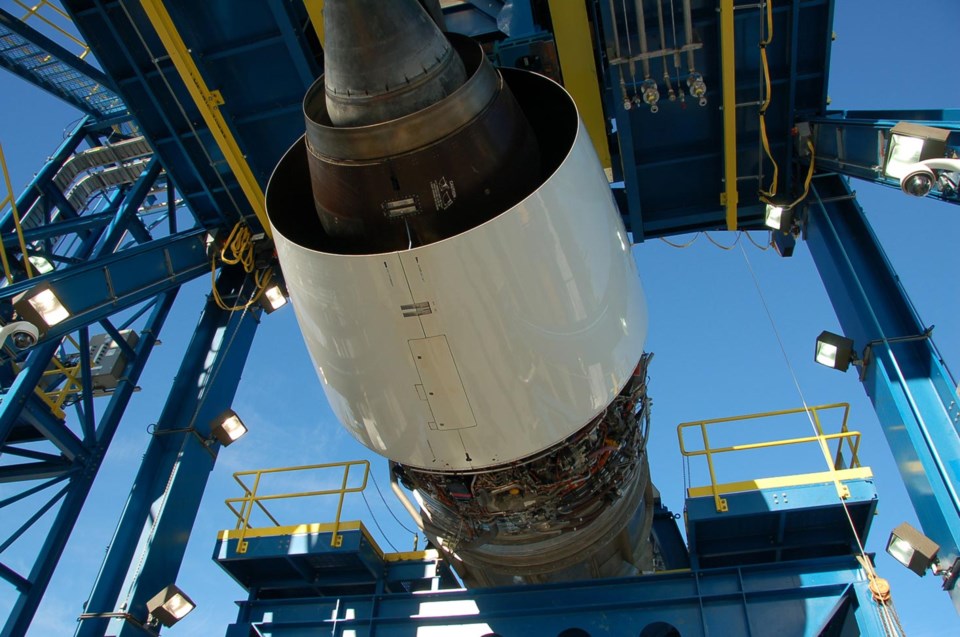The Global Aerospace Centre for Icing and Environmental Research (GLACIER) will hold one of its infrequent community open houses at its outdoor next generation experimental jet engine test facility June 14 from 9 a.m. to 3 p.m.
By opening its doors Saturday, local residents will get one of their few public opportunities to date to have a peek inside the state-of-the-art cold weather testing and certification centre, located at 100 Test Dr., about 10 kilometres south of Thompson, just west of Highway 6 and near Ospwagan Lake, since it opened almost four years ago on Oct. 29, 2010.
The facility is a ground-based open-air test stand capable of testing a very wide range of gas turbine engines. As an engine-generic installation, it includes the infrastructure and test systems necessary for the introduction of both current and future aerospace engines.
Thompson is classified as having sub-arctic weather conditions, make it an ideal location for outdoor icing tests, low temperature endurance testing, cold soak, and other adverse weather testing of flight vehicles and their propulsion systems. During the off-season, the facility also provides ideal conditions for other performance, endurance and operability testing.
Engines are iced at a series of discrete temperatures ranging from a high of about -2C to the coldest being around -23C, as part of the certification test program for an engine.
Because no public parking is available on site, a free shuttle bus will run between the northwest corner of the City Centre Mall's parking lot and the Global Aerospace Centre for Icing and Environmental Research every half hour from 9 a.m. until 2 p.m. Bus tickets are required and available from CIBC,TD Bank, Sears and M & M Meats.
GLACIER is a joint venture, with Rolls-Royce Canada Limited and Pratt & Whitney Canada being the principal owners, to advance research on internal icing in gas turbine engines. The two companies, who are competitors, came together for the joint venture because of the high capital costs in building such a test facility. Each company has its own control rooms and computer and data acquisition systems at the facility. The National Research Council of Canada and other research bodies are contributing their areas of expertise. In exchange for helping test and certify engine designs, the National Research Council gains access to the facility for research, development and training related to improving gas turbines and aircraft-icing sensors.
MDS AeroTest of Ottawa supports the operations and maintenance of the GLACIER test facility, which is considered the premier gas turbine test facility for icing on aircraft engines worldwide. MDS AeroTest has also been involved in testing in facilities in Montreal, West Virginia, England, Russia and Morocco.
The Global Aerospace Centre for Icing and Environmental Research is one of two jet engine test facilities in Manitoba. GE Canada owns the other site on Sargent Avenue at Winnipeg James Armstrong Richardson International Airport, which is operated by StandardAero, which was founded in 1911 and is headquartered in Tempe, Arizona. StandardAero is one of the world aerospace industry's largest independent maintenance, repair and overhaul providers.
Troy Ramnath, the chief facilities engineer for MDS AeroTest at the Global Aerospace Centre for Icing and Environmental Research here since March, previously was the senior project engineer for StandardAero in Winnipeg at the GE Canada-owned test site between May 2010 and last November. Prior to that he spent more than six years from December 2006 to February 2013 with StandardAero in Winnipeg as a 3D optical scanning specialist.
The two facilities are similar, but one main difference is that the Winnipeg testing centre is a "free jet" design while GLACIER is what's known as "direct connect." Both methods are acceptable to government certification authorities such as Canada's Department of Transport, the U.S. Federal Aviation Administration (FAA) and the European Aviation Safety Agency.




